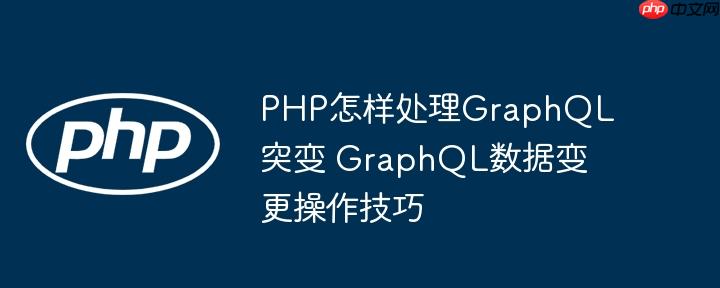
在 PHP 中,处理 GraphQL 突变(Mutation) 操作与查询(Query)类似,但主要用于修改服务器端数据,如添加、更新或删除记录。突变操作是 GraphQL 的核心功能之一,它允许客户端提交数据变更请求,并获得变更后的数据或状态。
本文将详细介绍如何使用 PHP 处理 GraphQL 突变操作,并提供一些实用的技巧来优化和处理数据变更。
1. GraphQL 突变基本概念
在 GraphQL 中,突变(Mutation)用于处理数据的修改操作(如创建、更新、删除)。它类似于 SQL 中的 INSERT、UPDATE 和 DELETE 语句。与查询不同,突变会改变服务器的数据,并且通常返回修改后的数据。
突变的示例:
mutation {
createUser(name: "John Doe", email: "john@example.com") {
id
name
email
}
}
该突变操作创建一个新用户,并返回用户的 id、name 和 email 信息。
2. PHP 中处理 GraphQL 突变
在 PHP 中处理 GraphQL 突变通常涉及以下几个步骤:
- 定义 GraphQL Schema:在 schema 中定义突变类型。
- 创建解析器(Resolver):实现突变的业务逻辑。
- 处理突变请求:使用
executeQuery执行突变操作,并返回结果。
3. 定义 GraphQL 突变类型
与查询类型(Query Type)类似,GraphQL 中的突变(Mutation Type)也需要定义数据类型、字段和解析器。以下是一个基本的突变操作,用于创建一个新用户。
3.1 定义用户类型和突变类型
首先,定义 User 类型和 Mutation 类型。在这里,我们定义一个 createUser 突变,用于创建用户。
<?php
use GraphQL\Type\Definition\ObjectType;
use GraphQL\Type\Definition\StringType;
use GraphQL\Type\Definition\IntType;
use GraphQL\Type\Definition\Schema;
use GraphQL\Type\Definition\FieldDefinition;
use GraphQL\Type\Definition\InputObjectType;
// 创建 User 类型
$userType = new ObjectType([
'name' => 'User',
'fields' => [
'id' => ['type' => new IntType()],
'name' => ['type' => new StringType()],
'email' => ['type' => new StringType()],
],
]);
// 创建 Mutation 类型
$mutationType = new ObjectType([
'name' => 'Mutation',
'fields' => [
'createUser' => [
'type' => $userType, // 突变操作返回的类型
'args' => [
'name' => ['type' => new StringType()],
'email' => ['type' => new StringType()],
],
'resolve' => function($root, $args) {
// 这里是创建用户的逻辑,模拟创建并返回用户
$newUser = [
'id' => rand(1, 1000), // 模拟生成一个用户 ID
'name' => $args['name'],
'email' => $args['email'],
];
return $newUser;
}
]
]
]);
// 创建 Schema
$schema = new Schema([
'query' => new ObjectType([
'name' => 'Query',
'fields' => [] // 空的查询字段,仅作为示例
]),
'mutation' => $mutationType, // 使用 Mutation 类型
]);
?>
4. 执行 GraphQL 突变
在 PHP 中,我们使用 GraphQL\GraphQL::executeQuery() 来执行 GraphQL 查询或突变操作。此方法接受 GraphQL Schema、查询字符串和其他可选参数。
4.1 执行突变操作
<?php
use GraphQL\GraphQL;
// 假设突变查询字符串来自客户端
$query = '
mutation {
createUser(name: "John Doe", email: "john@example.com") {
id
name
email
}
}
';
try {
// 执行 GraphQL 突变
$result = GraphQL::executeQuery($schema, $query);
// 返回结果,通常是 JSON 格式
echo json_encode($result->toArray());
} catch (\Exception $e) {
// 错误处理
echo json_encode(['error' => $e->getMessage()]);
}
?>
5. 复杂的突变操作
实际应用中,突变操作可能会更加复杂,涉及数据库操作、身份验证、权限检查等。下面是一个稍微复杂的示例,展示了如何进行更新和删除操作。
5.1 更新操作
$mutationType = new ObjectType([
'name' => 'Mutation',
'fields' => [
'updateUser' => [
'type' => $userType,
'args' => [
'id' => ['type' => new IntType()],
'name' => ['type' => new StringType()],
'email' => ['type' => new StringType()],
],
'resolve' => function($root, $args) {
// 模拟数据库更新
$updatedUser = [
'id' => $args['id'],
'name' => $args['name'],
'email' => $args['email'],
];
return $updatedUser;
}
]
]
]);
5.2 删除操作
$mutationType = new ObjectType([
'name' => 'Mutation',
'fields' => [
'deleteUser' => [
'type' => new StringType(), // 返回删除成功的消息
'args' => [
'id' => ['type' => new IntType()],
],
'resolve' => function($root, $args) {
// 模拟删除操作
return "User with ID {$args['id']} has been deleted.";
}
]
]
]);
6. 传入输入类型(Input Types)
有时突变操作需要接收复杂的输入结构,这时可以使用 Input Types。输入类型类似于普通的 Object 类型,但它用于传递嵌套的数据结构。
6.1 定义输入类型
// 定义 UserInput 类型,传递给突变操作
$userInputType = new InputObjectType([
'name' => 'UserInput',
'fields' => [
'name' => ['type' => new StringType()],
'email' => ['type' => new StringType()],
]
]);
// 在突变中使用输入类型
$mutationType = new ObjectType([
'name' => 'Mutation',
'fields' => [
'createUser' => [
'type' => $userType,
'args' => [
'user' => ['type' => $userInputType], // 使用输入类型
],
'resolve' => function($root, $args) {
// 这里使用 $args['user'] 来访问传递的输入数据
$newUser = [
'id' => rand(1, 1000),
'name' => $args['user']['name'],
'email' => $args['user']['email'],
];
return $newUser;
}
]
]
]);
6.2 调用输入类型
mutation {
createUser(user: {name: "Alice", email: "alice@example.com"}) {
id
name
email
}
}
7. 常见的 GraphQL 突变操作技巧
- 返回最新数据:在突变完成后返回修改后的对象,而不仅仅是成功与否的消息。例如,返回用户的更新信息或删除后的状态。
- 错误处理:在进行突变时,确保捕获并处理可能的错误(如数据库插入失败)。可以通过抛出异常并返回有意义的错误消息。
- 事务管理:如果突变涉及多个数据表的更新(如创建用户并同时更新其他相关数据),请确保操作在一个事务中进行,保证数据一致性。
- 权限验证:对于敏感的突变操作(如删除或更新),建议在解析器中添加权限验证逻辑,确保只有授权用户可以执行操作。
- 使用输入类型:对于复杂的嵌套数据结构,使用 GraphQL 的 Input Object Types 来封装传入数据,提高代码的可读性和可维护性。
总结
- 定义突变类型:在 GraphQL schema 中定义
Mutation类型及其字段,字段对应具体的变更操作。 - 解析器(Resolver):为每个突变字段定义
resolve函数,执行具体的业务逻辑,如数据插入、更新或删除。 - 执行突变:通过
executeQuery()执行突变查询,并处理返回结果。
使用 PHP 处理 GraphQL 突变时,可以灵
活运用输入类型、错误处理、事务等技巧,以确保数据变更操作的可靠性和安全性。